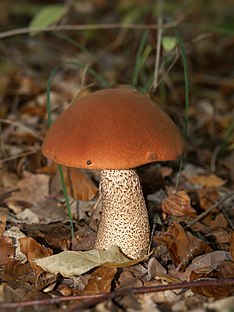Leccinum aurantiacum
| Leccinum aurantiacum | |
|---|---|
 |
|
| L. aurantiacum in a Luxembourg wood | |
| Scientific classification | |
| Kingdom: | Fungi |
| Division: | Basidiomycota |
| Class: | Homobasidiomycetes |
| Order: | Boletales |
| Family: | Boletaceae |
| Genus: | Leccinum |
| Species: | L. aurantiacum |
| Binomial name | |
|
Leccinum aurantiacum (Bull. ex St. Amans) |
|
| Synonyms | |
|
|
| Leccinum aurantiacum | |
|---|---|
| Mycological characteristics | |
| pores on hymenium | |
| cap is convex | |
| hymenium is adnate | |
| stipe is bare | |
| spore print is olive | |
| ecology is mycorrhizal | |
| edibility: edible | |
Leccinum aurantiacum, is a species of fungus in the genus Leccinum. It is found in forests of Europe, North America and Asia and has a large, characteristically red-capped fruiting body. In North America, it is sometimes referred to by the common name red-capped scaber stalk. There are some uncertainties regarding the taxonomic classification of this species in Europe as well as in North America. It is considered edible.
The cap is orange-red and measures up to 8 in (20 cm) across. Its flesh is white, bruising at first burgundy, then grayish or purple-black. The underside of the cap has very small whitish pores that bruise olive-brown. The stem measures 4-7 in (10-18 cm) tall and to a ¾-1¼ in (2-3 cm) thick and can bruise blue-green. It is whitish, with short, rigid projections or that turn to brown to black with age.
Leccinum aurantiacum can be found fruiting during summer and autumn in forests throughout Europe and North America. The association between fungus and host tree is mycorrhizal.
In Europe, Leccinum aurantiacum has been traditionally known to be associated with poplars (Populus). There exists some debate about the classification of L. aurantiacum and L. quercinum as separate species. According to authors who do not recognise the distinction, L. aurantiacum is also found with oak (Quercus). Additionally, L. aurantiacum has been recorded with various other deciduous trees including beech (Fagus), birch (Betula), chestnut (Castanea), willow (Salix), and Tilia.L. aurantiacum is not known to associate with conifers in Europe.
...
Wikipedia
